Australian Pulse Bulletin
Using pulses for forage
Pulses can be used as forage to provide flexibility in crop rotations, particularly if the pulse crop fails because of drought, frost or weeds. Many of the initial questions about pulses for forage are the same as would be asked for cereals and oilseeds in a similar situation. The answers may however differ slightly when timing and quality are considered.
-
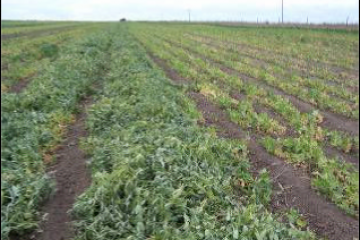
Peas cut for hay
-
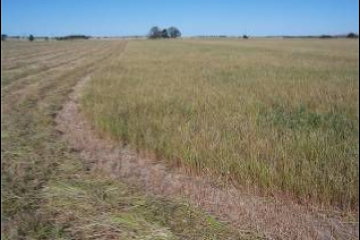
An extreme case of failed lupins cut because of poor ryegrass control
-
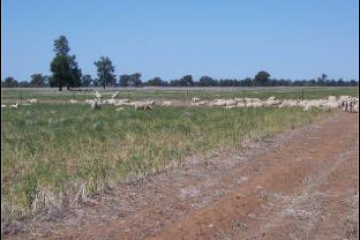
Grazing a standing lupin crop
-
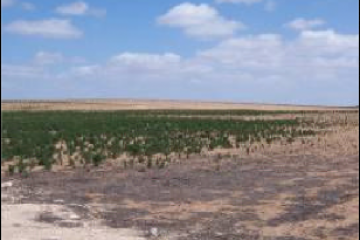
Erosion risk with poor lupin crop
-
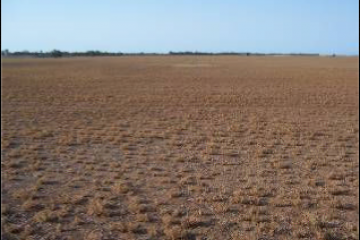
Lentils desiccated for weed control and soil protection
-
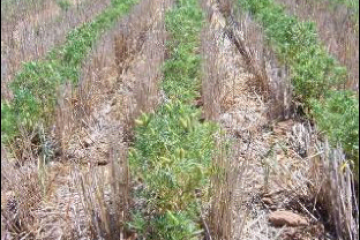
Lupins sown into standing cereal stubble
Questions to ask
You must ask questions of your main intentions, and do your sums on the alternatives:
- What will the crop yield? Has it the potential to produce more pods, and how much will be harvestable, i.e. what is the likely dollar return as grain vs the alternatives?
- Is there a need to control weeds in the crop, and is the opportunity to control weed seed set too good to miss?
- How do the costs of grain harvest compare to; baling/ensiling, harvesting via livestock grazing or doing nothing?
- If deciding to cut, should it be cut for hay, silage, or left in windrows to graze?
- Is desiccating an option to consider rather than cutting?
- Is there enough plant material to pick up from the windrow if cut?
- Will raised beds create difficulties in raking and picking up the windrow for baling?
- Will cut crops blow away before they can be baled?
- Is grazing it as a standing crop a better option?
- By not taking the pulse crop through to grain harvest, will there be stored moisture benefits that assist the subsequent crop, particularly in low rainfall environments (> 350 mm)?
- Are there benefits in soil nitrogen and fertility from either cutting the pulse or ‘green manuring’ or ‘brown manuring’ it?
- Do you graze the pulse, and if so, what are the erosion and soil compaction issues? Is grazing too risky?
- If you decide to graze the pulse, do you graze it now or later?
- When is the greatest livestock need versus the optimum utilisation of the forage?
- Do you graze the standing crop as it is now, or later?
- Do you desiccate the crop to eliminate weed seed set, and to ‘freeze’ the pulse quality prior to grazing?
- Do you cut the crop, and put it into a windrow for grazing?
We know that the quality of the pulse product is generally high, but it does depend on the stage the crop is cut, and how successful the baling or ensiling is. Are all the pulses the same?
If an option is to graze the failed pulse crop, the decision must be made as to:
There should be no toxicity problems or palatability issues, but there are some minor differences between the pulses. Ensure all the chemical witholding periods (WHPs) have been met (herbicides, insecticides, fungicides).
Quality
Pulse hay is not like pea straw or bean stubble, as its quality is much higher in metabolisable energy, protein and digestibility. The actual values depend on the crop growth stage at cutting, and how it is baled or ensiled to ensure the leaf and pod material is captured. There is minimal difference between the pulses. As with cereals cut for hay, the quality declines as the crop progresses from flowering, through pod fill (grain filling) and leaf loss as it approaches maturity. Frosted pulse crops will have started grain fill, so their quality will be intermediate unless no pods are formed.
Because the feed quality of pulses can vary so much dependent on crop stage at cutting, amount of grain present, weed or disease burden, weather conditions during curing and baling conditions, having a FEEDTEST® done will be important.
To give an idea of what quality could be expected, indicative values for pulses published on a dry matter basis would be expected to be;
- 8.0 to 11.0Mj/kg,
- 12 to 18 % crude protein and
- 60 to 70% dry matter digestibility, being similar to legume/clover hays, but perhaps less than many lucerne hays.
By contrast, a pea or bean straw after grain harvest would be:
- 6.0 to 7.0Mj/kg
- crude protein less than 5%.
Cereal hays would be:
- 7.5 to 9.0Mj/kg,
- 6.0 to 12.0% crude protein
- 55 to 70% digestibility.
Cereal straws/stubble would be:
- 5.0 to 6.5.0Mj/kg,
- crude protein at less than 4%, and
- digestibility at 35 to 50%.
FEEDTEST® values recorded within each crop type indicate that some individual samples have tested better and others far worse than the ranges indicated for the forage type. For example, field pea hay measured by FEEDTEST® on a dry matter basis has averaged at 9.8Mj/kg Metabolisable Energy (ME) with a range of 5.1 to12.5Mj, 15.8% crude protein (CP) with a range of 4.5 to 23.1%, and 67% dry matter digestibility (DMD) with a range of 38.0 to 81.8%. More limited FEEDTEST® results indicate that the averages of the other pulses cut for hay or silage are also similar to peas, and fit into the ranges of pulse quality listed.
Likely yield assessment
To assess the pulse grain yield, it is best to assess the average plants per square metre, and estimate grain yield from the number of seeds present and their estimated seed weight. For example, 20 plants/sqm x 10 seeds/plant x seed weight of 0.50g in beans = 20 x 10 x 0.5 = 100g/sqm = 1.0t/ha grain. In peas, 40 x 10 x 0.2 = 0.8t/ha. Harvest ability issues need to be considered if the lower pods are close to the ground.
To assess the likely yield of forage is more difficult, and depends on plant height and stage of pod fill. As a guide, in a pulse crop that totally failed from frosted pods, the forage yield may be 1.0 to 1.5 times the anticipated grain yield of the crop had it not frosted. If any unfrosted grain is present in pods, this would boost the forage yield.
Timing
In frosted pulse crops there is not the same urgency to cut them quickly as with cereals, as the quality does not decline rapidly within days of the frost. There is also the chance of compensation through further flowering or podding if moisture is sufficient. Lack of moisture may well influence the final timing decision, to ensure the crop is cut before leaf drop, and grain yield is better known.
The process
Pulse stems dry slower than the leaf, and so there is the need to condition the pulse crop at mowing. Lupins will be the most difficult, with fine leaves and thick stems, compared with peas and vetch being the best for stem versus leaf drying. Quality is lost if leaf is lost during the baling operation. This is why some choose to ensile (haylage), but there are risks if ensiling or baling is done too wet.
Flexibility
While frost and drought are seen as set-backs in pulse grain production, in many areas pulses are viewed as a flexible option in the cropping rotation. While the main intention may be to harvest grain, should drought, frost, weeds or livestock needs dictate, alternatives become possible. The pulse can be cut for hay, desiccated for ‘brown manuring’, grazed, or even ploughed in to improve soil structure. In mixed enterprises the pulse crop assists in integrating the whole farm system to fit into grazing and cropping systems, whether it be as grain, stubble, forage or as ‘brown manure’.
Feed test
Forages are often sold on an energy basis, with protein and digestibility a factor. Because pulse crop fodder is usually of high quality, it will pay to have a FEEDTEST® performed to ensure that payment is based on product quality.
Palatability
There can be initial acceptance or palatability issues with stock grazing standing pulse crops, with peas, vetch and lupins being some of the more palatable initially, and beans perhaps one of the least. However, pulse crops will be totally consumed once the stock become accustomed to the crop. Young growing stock may suffer a brief set-back on introduction to the pulse until they get used to them. Pre-conditioning them may assist and avoid any digestive issues if hungry sheep enter the pulse crop from dry feed.
Feeding of pulse hays may give similar initial palatability effects, but the hay will be consumed with perhaps only a few thick portions of stem left.
Chickpeas are less suited to grazing, and possibly hay as well due to the malic acid coating on their leaves that affects palatability. Kabuli chickpeas are more palatable than desi types, and it is the flowers, pods and uppermost stems that get eaten first.
Risks
As a producer or user of pulse forage, there are minimal risks. Lupinosis in lupins is often incorrectly assumed to be a major issue with lupin crop forages. It is in fact less of a risk in lupin hay than it is in grazing the lupin stubble. Cutting or desiccating the lupin crop dries it down quickly, and in so doing reduces the Phomopsis fungus on the stems. Provided the lupins have dried down normally, even wetting up again with rain on the windrow, once dry, does not pose the same risks of lupinosis as it would on stubble.
Grazing
The issue is when the grazing is needed, and for how long. If grazing a standing, green pulse crop, then the leaf material is only able to be captured until dry conditions set in. If left until maturity, the leaf material is lost, and the quality has deteriorated as it matured. Cutting or desiccating helps preserve the quality, and might enable the leaf to be grazed, particularly if in a windrow. The grazing value of pulse stubble or a standing, mature crop is predominantly in the grain. Stock can be finished on pulses if the stocking rate is adequate to enable the grain consumed to remain until the stock are ready for slaughter. Droughted or frosted pulses have minimal grain present, so cannot be considered ideal for finishing livestock, even though the forage available is of better quality than pulse stubble residue.
Environmental issues
There are possible environmental and soil factors to consider when baling, ensiling or grazing a pulse crop.
- The loss of organic matter and nutrients from the system
- Eliminating the need to burn stubbles, particularly in cereals
- The soil erosion risk of grazing, through powdering up the remaining crop residue over summer and leaving no soil cover for the new crop when sown. This will be no more than from grazing normal pulse stubble, possibly even less.
- There may actually be more root and plant residues after cutting a pulse crop than after grain harvest. This is true with peas especially, provided the residue is not grazed.
- The extra traffic on the pulse area during forage operations, and possible compaction, even though the soil may be dry at the time
- The straying from controlled traffic situations, and the complications of cutting forage on raised beds.
The loss of income from not cutting or grazing the failed pulse must be weighed up against the opportunity for weed control and the beneficial environmental effects.
Conclusions
1. Do your sums
- What are the best returns for you?
- What benefit to your crop rotations can accrue through weed control?
- How can the pulse fit the grazing system?
- Can the pulse be marketed through your livestock rather as a grain or fodder commodity?
2. Pulse hay and silage is of high quality
- Timing is important.
- The baling or ensiling operations need to dry the stems and keep the leaf material.
3. Users of pulse forage can have confidence in the product, particularly if a FEEDTEST® has been done.
4. Organise your sowing seed supplies for next season early, well before sowing.
5. Consider any erosion, soil compaction and nutrient loss implications.
Key contacts
Disclaimer
Information provided in this guide was correct at the time of the date shown below. No responsibility is accepted by Pulse Australia for any commercial outcomes from the use of information contained in this guide.
The information herein has been obtained from sources considered reliable but its accuracy and completeness cannot be guaranteed. No liability or responsibility is accepted for any errors or for any negligence, omissions in the contents, default or lack of care for any loss or damage whatsoever that may arise from actions based on any material contained in this publication.
Readers who act on this information do so at their own risk.
Copyright © 2015 Pulse Australia
All rights reserved. The information provided in the publication may not be reproduced in part or in full, in any form whatsoever, without the prior written consent of Pulse Australia.
Last updated: 20 November 2015
